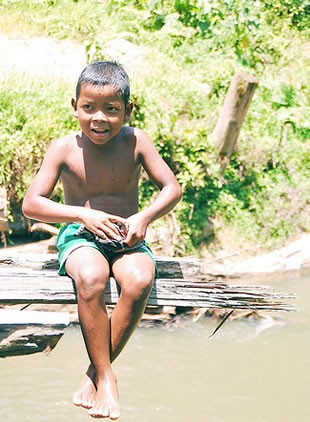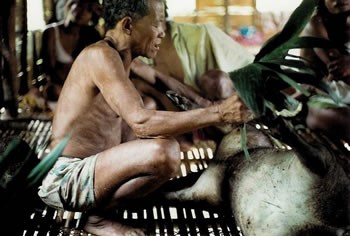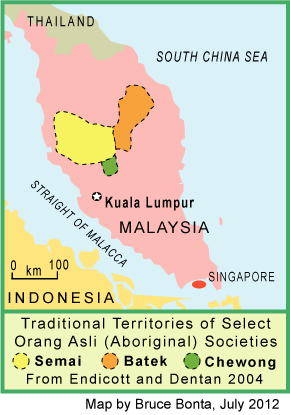Location. As of 2007, about 43,500 Semai, an Orang Asli society (Malay for “Original People”), lived in the forested central mountains in Pahang and Perak states of the Malay Peninsula in Malaysia, Southeast Asia.

Economy. The Semai have traditionally subsisted on the cultivation of manioc and rice, plus fishing, hunting, and trade in so-called “minor forest products” such as rattan. Increasingly, however, at least some are getting educations, and in a few cases university degrees. Some are entering professions as well as the labor pools in local towns. One Semai village, Ulu Geroh in Perak state, has successfully built up a tourist business. A video released to YouTube in 2012 provides an effective portrayal of Ulu Geroh and the way it retains its traditional values while hosting tourists. A news report from 2010, however, describes the poverty that prevails in another Semai village, apparently caused by the desecration of their forests. On the other hand, a news story from 2015 describes the prosperity in a different Semai community.
Beliefs that Foster Peacefulness. The Semai have a strongly nonviolent image of themselves; they proclaim themselves to be nonviolent people who do not get angry or hit others. In fact, they do quarrel and get angry at times, but aggressive expressions of anger are rare, and they almost never hit their children. They see themselves as non-aggressive, dependent and nurturant. A self-image that allowed aggression would contradict their definition of virtue. Their worldview, and humanity’s place in it, does not include any violence. They see themselves as helplessly surrounded by hostile forces, both natural and supernatural, and they proceed with caution in all their daily activities in the face of ubiquitous dangers. Security comes only from the sharing, peace and integration of their villages. A panelist at a conference in 2011 argued that the Semai exemplify equality, sustainability and peacefulness, qualities that foster human interdependence with one another and with the natural world. Another scholar maintained in a 2014 journal article that the Semai toponyms help reinforce their feelings of the importance of remaining highly peaceful.

Avoiding and Resolving Conflict. Before they moved into permanent villages, the Semai preferred to resolve serious disputes informally, through such strategies as separation, gossip, or shaming, particularly of individuals that the community believed were responsible for causing problems. The Semai still frequently practice such informal conflict resolution strategies, but they have also adopted, and modified for their own purposes, the use of more formal meetings as practiced by the surrounding, dominant, Malay peoples. The purpose, for the Semai, of having such a formal meeting, called a bcaraa’, is to settle the dispute rather than to determine guilt or innocence. After a lot of socializing, a headman will give a long lecture on the importance of group solidarity, mutual dependence, and peace. Then the principals to the dispute will present their viewpoints in speeches that may continue for many hours, until no one has anything additional to say and everyone is exhausted. The headman then concludes the bcaraa’, perhaps by levying small fines if appropriate, and he continues by lecturing everyone on correct, peaceful Semai behavior. The meeting resolves the dispute itself, reconciles the parties, dissipates their emotions, reintegrates the whole village, reaffirms everyone’s interdependence, and re-confirms the importance of nonviolent behavior.
Gender Relations. The social structure of the Semai includes a clear but not rigid division of labor between the sexes: there are no separate ideals for women versus men, and no tasks that are strictly for women or men. The newly married Semai couple often lives for weeks in the wife’s settlement (usually spouses are from different settlements); then they live in his, then hers, and so on, the visits lengthening until they finally settle down in one or the other. The people in the East Semai region—who have less contact with the Malay peoples—have no formal marriage ceremonies. When a couple starts living together, they are considered husband and wife; if they no longer sleep and eat together, they are considered separated.
Raising Children. Infants are cared for and loved constantly but they face a rude awakening when they are about two and their mothers decide they have other work to do and cannot continue providing constant nurturing. From two until about four, the child discovers that crying and violent temper tantrums bring no response from the parents or anyone else in the village. Children thus lose their feelings of dependency on the parents alone, and begin to seek support from the whole community. Children do not see aggression by adults, and when they fight among themselves a parent will normally take the angry child away from its game and back to the house, reinforcing their taboo against violence and anger. Children do not play competitive games. Semai parents are usually enthusiastic about their children attending school, but it is sometimes difficult for the kids to get there, and conditions for them at the schools are often unfavorable, as reports in July and December 2014 indicated.
Social Practices. For the Semai, the ideal adult man has a good relationship with his wife, loves his children more than anything, has a normal sexual appetite, a good appetite, and a healthy, cool body. He keeps his feelings and thoughts within. He does not cause difficulties for others and does not try to make someone, even his own child, do something contrary to that person’s will. He does not harm strangers, even though he mistrusts them, and if attacked he will open his arms hoping to shame the attacker out of his aggressiveness, or he will flee.
 Sense of Self. The Semai learn during childhood to fear emotional arousal of any kind, especially anger, which they see as highly threatening. They vastly exaggerate the consequences of corporal punishment of children, which might result from anger: if a child were spanked, he or she might die. They are quite restrained in their mourning, their anger, even their laughter; their interpersonal relationships are reserved. The only emotion they express openly, without reservation, is fear—of strangers and especially of violent thunderstorms. An onrushing thunderstorm arouses massive, and to a westerner highly irrational, fear.
Sense of Self. The Semai learn during childhood to fear emotional arousal of any kind, especially anger, which they see as highly threatening. They vastly exaggerate the consequences of corporal punishment of children, which might result from anger: if a child were spanked, he or she might die. They are quite restrained in their mourning, their anger, even their laughter; their interpersonal relationships are reserved. The only emotion they express openly, without reservation, is fear—of strangers and especially of violent thunderstorms. An onrushing thunderstorm arouses massive, and to a westerner highly irrational, fear.
Sharing. The Semai have two primary moral values: avoiding violence and sharing food. Semai women share the manioc that they harvest immediately after they return to the village from their fields. Likewise, Semai men share the fruits of their hunting, fishing, or gathering. These patterns are all quite sensible since they have no way to preserve foods, though food sharing frequently has little practical value, as one person will share a portion of a harvest or gathering expedition, only to have the recipients share portions of their foods shortly thereafter. But these sharing experiences are important for their symbolic, public statements of mutual dependence, nurturance, and the close ties of the band. No one seems to calculate the extent of their giving or receiving.
But How Much Violence Do They Really Experience? Despite the fact that they have a highly nonviolent society, when some Semai men were recruited in the early 1950s to help the British army fight a communist guerrilla insurgency, some became aggressive fighters, though when they returned to their own settlements they returned to their peaceful, nonviolent ways. While violent homicides are abhorrent to the Semai, there have been a few recorded instances of murders. Undoubtedly, the introduction of firearms and alcohol is becoming a problem that threatens Semai peacefulness. Furthermore, while some Semai maintain that they will die before fighting against outsiders who are taking away their lands, others feel their nonviolence cannot last forever against outside aggression and alcohol.
Scholarly Resources in this Website:
- “Semai Response to Mental Aberration.” (Dentan, 1968)
- “Ambivalences in Child Training by the Semai of Peninsular Malaysia and Other Peoples.” (Dentan, 2001)
- “Frustration, Aggression, and the Nonviolent Semai.” (Robarchek, 1977)
- “Conflict, Emotion, and Abreaction: Resolution of Conflict among the Semai Senoi.” (Robarchek, 1979)
- “The Image of Nonviolence: World View of the Semai-Senoi.” (Robarchek, 1981)
- “A Community of Interests: Semai Conflict Resolution.” (Robarchek, 1997)
- “Cultures of War and Peace: A Comparative Study of Waorani and Semai.” (Robarchek and Robarchek, 1992)
- “Reciprocities and Realities: World Views, Peacefulness, and Violence among Semai and Waorani” (Robarchek and Robarchek, 1998)
More Resources in this Website:
- Links between some Semai communities and the modern world are minimal. In one, the people lack good telephone and Internet connections, while in another, computer literacy skills are as minimal as their levels of formal education.
- The Semai consider the forests to be their workplaces, their shopping malls, and the centers of their culture, religion, and sustenance. Nonetheless, that general feeling of reverence for nature did not prevent one Semai man from engaging in a tiger poaching ring—though he was mauled by a tiger in the process.
- According to one news report, Semai folklore treats snakes as protective spirits that help them maintain their peacefulness.
- For the Semai in one village, wild, native plants provide many health and medical benefits.
- A prominent Semai woman activist was recognized in 2011 for her outstanding leadership.
- Tourism has become an important source of livelihood in one Semai village.
Sources in Print: Dentan 1968a, 1988, 1993, 1995, 2001, 2004; 2008; Dentan et al 1997; Robarchek 1977a, 1977b, 1979, 1981, 1986, 1989; Robarchek and Dentan 1987; Robarchek and Robarchek 1992
Sources on the Web: Endicott and Dentan 2004; Center for Orang Asli Concerns; Dentan 1999; Orang Asli Archive; Wikipedia (English version)
Updates—News and Reviews:
Selected Recent Stories
December 24, 2015. Preserving the Semai Language [conference paper review]
October 8, 2015. Semai Win Land Rights in Malaysian Court
June 18, 2015. Orang Asli Land Rights
April 30, 2015. Semai Women Making Progress
All Stories
All stories in this website about the Semai are listed in the News and Reviews Subject Listing
